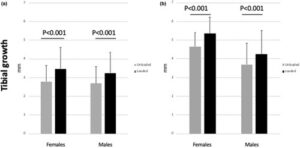There is evidence that the gut microbiome influences height via IGF-1. Microbiomes are passed on from mothers to children so it is non genetic way to influence height. Here’s more information about how the guy microbiome influences height.
The gut microbiome is definitely something that has a lot of effort put into it by the scientific community so there is potential to optimize the gut microbiome to make people taller.
Island biogeography theory provides a plausible explanation for why larger vertebrates and taller humans have more diverse gut microbiome
“Prior work has shown a positive scaling relationship between vertebrate body size, human height, and gut microbiome alpha diversity.{this means that the more diverse your gut microbiome the taller you were. This could be a correlation rather than causal if there is a factor that increases human height and gut microbiome diversity}.
This observation mirrors commonly observed species area relationships (SARs) in many other ecosystems. Here, we expand these observations to several large datasets, showing that this size–diversity scaling relationship is independent of relevant covariates, like diet, body mass index, age, sex, bowel movement frequency, antibiotic usage, and cardiometabolic health markers. Island biogeography theory (IBT), which predicts that larger islands tend to harbor greater species diversity through neutral demographic processes, provides a simple mechanism for positive SARs. Using a gut-adapted IBT model, we demonstrated that increasing the length of a flow through ecosystem led to increased species diversity, closely matching our empirical observations. We delve into the possible clinical implications of these SARs in the American Gut cohort. Consistent with prior observations that lower alpha diversity is a risk factor for Clostridioides difficile infection (CDI), we found that individuals who reported a history of CDI were shorter than those who did not and that this relationship was mediated by alpha diversity.{so increased microbiome diversity reduces the risk of infection}.
We observed that vegetable consumption had a much stronger association with CDI history, which was also partially mediated by alpha diversity. In summary, we find that the positive scaling observed between body size and gut alpha diversity can be plausibly explained by a gut-adapted IBT model, may be related to CDI risk, and vegetable intake appears to independently mitigate this risk, although additional work is needed to validate the potential disease risk implications.”
So this indicates that vegetable intake is a good way to increase microbiome diversity.
“The human gut microbiota has an enormous impact on our phenotype, with almost half of the metabolites circulating in blood significantly associated with cross-sectional variation in the ecological composition of the gut microbiome. One of the key ecosystem functions that the gut microbiota provides to its host is resistance to enteric bacterial pathogens. Niche saturation or nutrient competition are commonly invoked mechanisms for how the microbiota excludes invaders.”
“species-diverse commensal communities are more apt to saturate available metabolic niches
so that an invasive pathogen is less likely to colonize, outcompete commensals, and cause disease”<- so one of the ways that the gut microbiome increases height is by competing with invading pathogens and thereby preventing them from stunting growth. However if it is due to preventing infection that height is increased it could mean that for the average person the microbiome has less impact on height if they would not get an infection otherwise. On the other hand, the microbiome has been shown to have other effects that influence height such as via IGF-1.
“Vertebrate body size, which varies over six orders of magnitude, has been shown to be positively associated with gut microbiome alpha diversity, indicating that larger animals with larger guts harbor more species.” <-so the correlation could be possibly caused by larger people having larger guts which enable more microbiome diversity.
“we demonstrate a consistent scaling between body size and gut microbiome alpha diversity across vertebrates and human populations. We find that this association is independent of many potential confounders, like diet, bowel movement frequency (BMF), body mass index (BMI), age, and sex”
What the next steps would be to test the influence of the microbiome would be to compare the growth rates of different animals versus microbiome diversity who have never had an infection.
But with the frequency that kids get sick even if microbiome only reduces infection risk then it is worth it.

